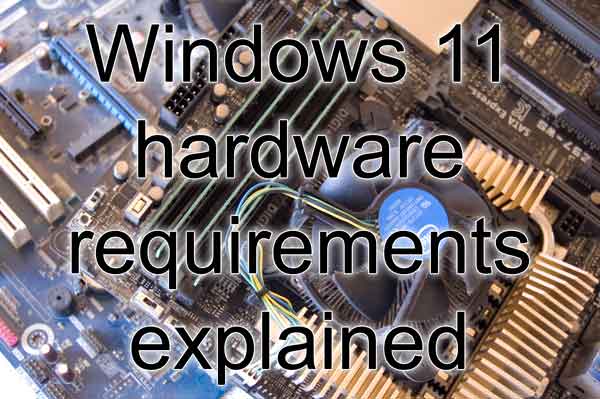Are you confused about the hardware requirements for Windows 11? Want to know why your computer can or cannot be upgraded to Windows 11? Let's take a detailed look at the hardware requirements for Windows 11.

With Windows 11, Microsoft is focusing on security and is starting to enforce the hardware requirements to run it. Previous versions of Windows (10, 8.1, and 7) all had the exact general hardware requirement.
But with Windows 10, the security requirements were still there, but they were not being enforced. The Unified Extensible Firmware Interface (UEFI), Secure Boot, and Trusted Platform Module (TPM) (see below) requirements were optional for Windows 10 to install and run.
Case in point, TPM has always been required for BitLocker encryption to be enabled. Windows 10 would use either TPM 1.2 or TPM 2.0. But the TPM 1.2 standard has been depreciated, so TPM 2.0 is now the defacto standard.
And if you look into UEFI, you will find that Secure Boot is part of that standard. And since UEFI can take advantage of TPM, it makes sense to include all three (3) in the requirements for Windows 11.
Note: Sorry for anybody still running a 32-bit version of Windows 10, but Windows 11 is only available in a 64-bit version.
Hardware requirements for Windows 7, 8.1 and 10
Processor - 1 Gigahertz (GHz) or faster 32-bit (x86) or 64-bit (x64) processor
Memory - 1 Gigabyte (GB) RAM (32-bit) or 2 GB RAM (64-bit)
Storage - 16 GB (32-bit) or 20 GB (64-bit)
Graphics card - Compatible with DirectX 9 with WDDM 1.0 or higher driver
Hardware requirements for Windows 11
Processor - 1 Gigahertz (GHz) or faster with two or more cores on a compatible 64-bit processor or System on a Chip (SoC). This requirement is now particular on what processors are compatible with Windows 11. General Rule of thumb: If the processor is less than three (3) years old, it should run Windows 11. Microsoft has a list of processors that are compatible with Windows 11.
Memory - 4 Gigabytes (GB) RAM. This requirement has increased from 2GB to 4GB, which is no biggie. I have not seen a computer with only 2 GB of memory in over a decade now.
Storage - 64 GB or larger storage device. This requirement has also increased, and it is about time. I have seen Windows 8.1 and Windows 10 installed on 32 GB drives, which is not pretty. The biggest problem is there usually is not enough free space to perform a feature update. I recommend at least a 256 GB drive for the operating system and programs.
Graphics card - DirectX 12 graphics device or later with WDDM 2.0 driver. Since DirectX 12 was released with Windows 10 back in 2015, most modern graphic cards will be compatible with Windows 11.
Hardware requirements that are no longer optional
Display - High definition (720p) display greater than 9" diagonally, 8 bits per color channel. This requirement is pretty easy to meet.
System firmware - UEFI and Secure Boot capable. UEFI (Unified Extensible Firmware Interface) has been used for over a decade now, so most computers running have UEFI enabled. And since the Secure Boot specification is part of the UEFI, that too should already be in place. However, you may have to change some settings in your computer's BIOS (Basic Input / Output System) to enable UEFI and Secure Boot.
TPM - Trusted Platform Module (TPM) 2.0. Besides the processor requirement, this is another stumbling point for upgrading to Windows 11. A TPM can be a separate module that you connect to your motherboard or be part of the chipset on your motherboard. Most modern motherboards will use FTPM (Firmware Trusted Platform Module) that is included in the chipset. However, you may have to change some settings in your computer's BIOS (Basic Input / Output System) to enable the TPM.
Storage structure - There are two (2) types of drive structures; MBR (Master Boot Record) and GPT (GUID Partition Table). Previous versions of Windows would run on either of these structures. Windows 11 requires GTP for the drive that contains Windows 11. Microsoft has included a tool inside Windows 10 to convert drives from MBR to GPT. Here is a link to the documentation for MBR2GPT.EXE.
b3c6a384-139e-424e-8d7f-d9faca6c55a3|0|.0|96d5b379-7e1d-4dac-a6ba-1e50db561b04